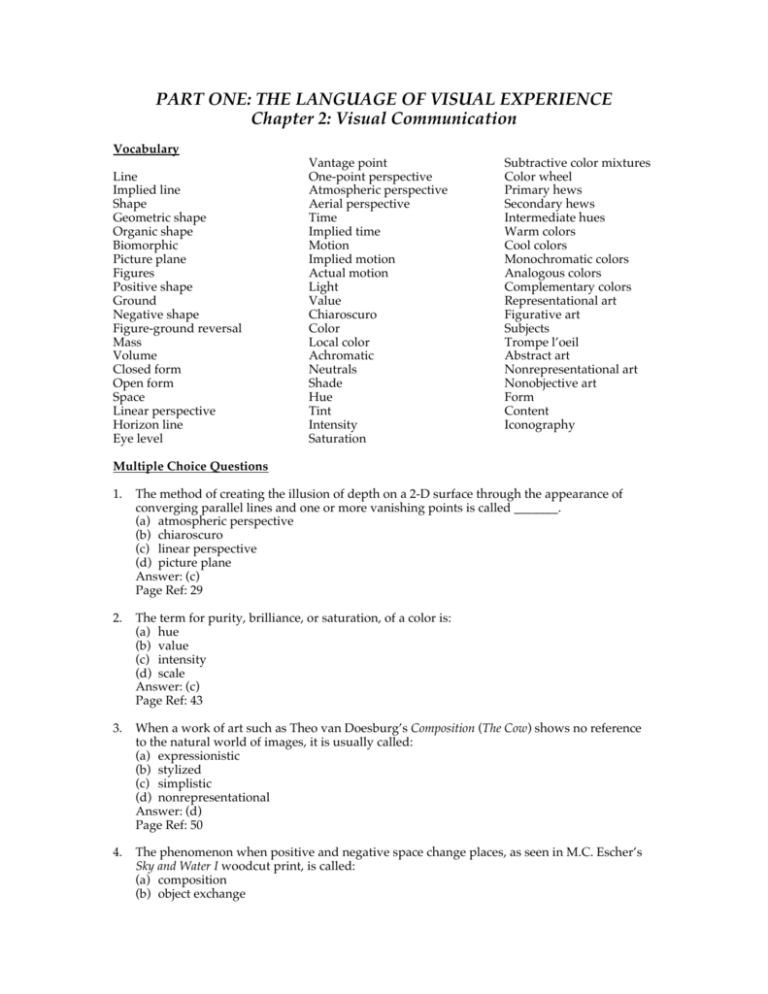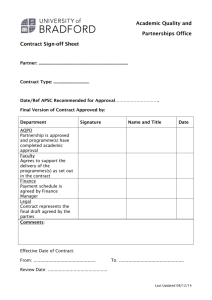THE LANGUAGE OF VISUAL EXPERIENCE Chapter 2
advertisement

PART ONE: THE LANGUAGE OF VISUAL EXPERIENCE Chapter 2: Visual Communication Vocabulary Line Implied line Shape Geometric shape Organic shape Biomorphic Picture plane Figures Positive shape Ground Negative shape Figure-ground reversal Mass Volume Closed form Open form Space Linear perspective Horizon line Eye level Vantage point One-point perspective Atmospheric perspective Aerial perspective Time Implied time Motion Implied motion Actual motion Light Value Chiaroscuro Color Local color Achromatic Neutrals Shade Hue Tint Intensity Saturation Subtractive color mixtures Color wheel Primary hews Secondary hews Intermediate hues Warm colors Cool colors Monochromatic colors Analogous colors Complementary colors Representational art Figurative art Subjects Trompe l’oeil Abstract art Nonrepresentational art Nonobjective art Form Content Iconography Multiple Choice Questions 1. The method of creating the illusion of depth on a 2-D surface through the appearance of converging parallel lines and one or more vanishing points is called _______. (a) atmospheric perspective (b) chiaroscuro (c) linear perspective (d) picture plane Answer: (c) Page Ref: 29 2. The term for purity, brilliance, or saturation, of a color is: (a) hue (b) value (c) intensity (d) scale Answer: (c) Page Ref: 43 3. When a work of art such as Theo van Doesburg’s Composition (The Cow) shows no reference to the natural world of images, it is usually called: (a) expressionistic (b) stylized (c) simplistic (d) nonrepresentational Answer: (d) Page Ref: 50 4. The phenomenon when positive and negative space change places, as seen in M.C. Escher’s Sky and Water I woodcut print, is called: (a) composition (b) object exchange (c) implied exchange (d) figure-ground reversal Answer: (d) Page Ref: 25 5. The realistic manner in which William Harnett painted A Smoke Backstage is called: (a) abstract (b) painterly (c) nonrepresentational (d) trompe l’oeil Answer: (d) Page Ref: 48 6. In the photograph Pepper #30, this artist combines awareness, creativity, and communication by encouraging the viewer to look closely at an object. (a) Otto Dix (b) Vincent van Gogh (c) Edward Weston (d) Henri Rousseau Answer: (c) Page Ref: 20 7. Jack-in-the-Pulpit No. V is typical in style and content of the artist: (a) Georgia O’Keeffe (b) Nancy Graves (c) Constantine Brancusi (d) Jean-Michel Basquiat Answer: (a) Page Ref: 54 8. The symbolic meaning of visual signs and imagery is called: (a) content (b) iconography (c) form (d) aesthetics Answer: (b) Page Ref: 55 9. Objective or figurative art is considered: (a) representational art (b) abstract art (c) nonrepresentational art (d) folk art Answer: (a) Page Ref: 47 10. In The Kiss, the artist Rodin expressed the _______ of love, while the artist Brancusi expressed the _______ of love. (a) look; touch (b) thought; heartbreak (c) risk; satisfaction (d) feeling; idea Answer: (d) Page Ref: 52 11. In his image Untitled Keith Haring has used _______ colors. (a) objective (b) analogous (c) tertiary (d) complementary Answer: (d) Page Ref: 47 12. The work Untitled by _______ emphasizes implied motion. (a) Jenny Holzer (b) Marc Chagall (c) Kristin Jones (d) Harold Edgerton Answer: (a) Page Ref: 37 13. Raphael’s The School of Athens provides the viewer with the illusion of the three-dimensional world on a two-dimensional surface by the use of: (a) cross hatching (b) the golden mean (c) symmetrical balance (d) linear perspective Answer: (d) Page Ref: 31 14. The term “value,” in the sense of art, refers to the: (a) lightness and darkness of surfaces (b) brightness and dullness of surfaces (c) foreground and background (d) quality of line and shape Answer: (a) Page Ref: 39 Short Answer Questions 16. Differentiate between form and content. 17. Compare and contrast Harnett’s A Smoke Backstage with Rene Magritte’s The Treason of Images. In what manner did the artists’ motivations affect each work? 18. Identify the characteristics of “cool” and “warm” colors? Give examples for each. 19. Discuss Isaac Newton’s contributions to our understanding of color. 20. Define chiaroscuro. 21. There are several techniques artists have used to create the illusion of depth on a flat surface. Identify three of these techniques. 22. List some characteristics of line in Marc Chagall’s I and the Village. Essay Questions 23. Compare and contrast the use of perspective in Raphael’s The School of Athens with Durand’s Kindred Spirits. 24. Compare and contrast the use of mass and space in Giacometti’s Man Pointing with Qennefer, Steward of the Palace. 25. Compare and contrast Betye Saar’s Liberation of Aunt Jemima with Carlos Fresquez's "Yellow Wall." What social issues is each attempting to address? 26. Compare and contrast Rodin’s The Kiss with Brancusi’s The Kiss. In what way does their approach change the content? 27. Discuss how Ancient Egyptians used mass in their sculpture. How did the Egyptians’ beliefs affect their use of mass in art and architecture? 28. Describe how Shen Zhou uses the element of design in his artwork Poet on a Mountain Top. Which elements were excluded and why? 29. Discuss how light may be utilized in artworks. Citing examples, describe how the western approach to light has differed from eastern cultures. 30. Discuss the function of the color wheel. What is the significance of the primary colors? What are some color schemes artists have used in their work? Explain. 31. Describe the work of Georgia O’Keeffe. What was her unique approach toward art? What influenced her content?





